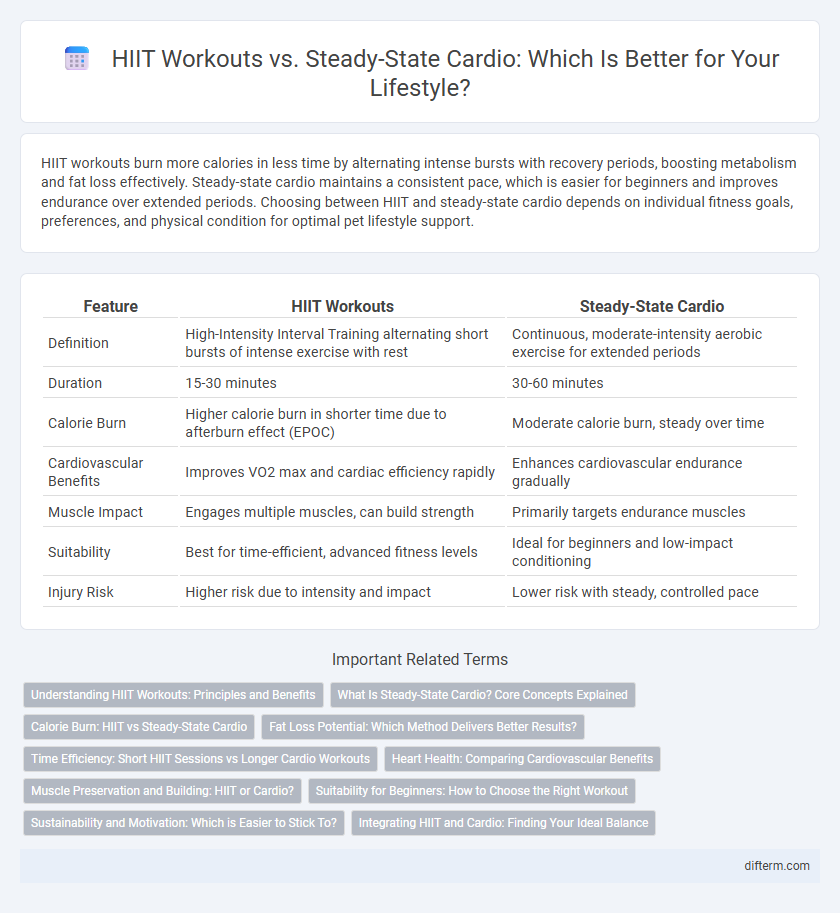HIIT workouts burn more calories in less time by alternating intense bursts with recovery periods, boosting metabolism and fat loss effectively. Steady-state cardio maintains a consistent pace, which is easier for beginners and improves endurance over extended periods. Choosing between HIIT and steady-state cardio depends on individual fitness goals, preferences, and physical condition for optimal pet lifestyle support.
Table of Comparison
| Feature | HIIT Workouts | Steady-State Cardio |
|---|---|---|
| Definition | High-Intensity Interval Training alternating short bursts of intense exercise with rest | Continuous, moderate-intensity aerobic exercise for extended periods |
| Duration | 15-30 minutes | 30-60 minutes |
| Calorie Burn | Higher calorie burn in shorter time due to afterburn effect (EPOC) | Moderate calorie burn, steady over time |
| Cardiovascular Benefits | Improves VO2 max and cardiac efficiency rapidly | Enhances cardiovascular endurance gradually |
| Muscle Impact | Engages multiple muscles, can build strength | Primarily targets endurance muscles |
| Suitability | Best for time-efficient, advanced fitness levels | Ideal for beginners and low-impact conditioning |
| Injury Risk | Higher risk due to intensity and impact | Lower risk with steady, controlled pace |
Understanding HIIT Workouts: Principles and Benefits
HIIT workouts involve short bursts of intense exercise followed by brief recovery periods, maximizing calorie burn and improving cardiovascular fitness in less time than steady-state cardio. This training method enhances metabolic rate both during and after exercise, promoting fat loss and muscle endurance effectively. Research shows HIIT also increases aerobic capacity and insulin sensitivity more significantly than traditional steady-state cardio, making it a preferred choice for efficient and dynamic fitness routines.
What Is Steady-State Cardio? Core Concepts Explained
Steady-state cardio involves maintaining a consistent, moderate intensity level throughout the workout, typically lasting 30 to 60 minutes, such as jogging, cycling, or swimming at a steady pace. This type of cardiovascular exercise focuses on improving endurance and fat metabolism by keeping the heart rate within a target zone, usually 50-70% of maximum heart rate. It contrasts with HIIT by promoting sustained aerobic activity that enhances cardiovascular health and supports gradual calorie burn.
Calorie Burn: HIIT vs Steady-State Cardio
HIIT workouts maximize calorie burn by combining intense bursts of activity with short recovery periods, boosting metabolism and increasing post-exercise oxygen consumption for hours after the session. Steady-state cardio burns calories consistently during the exercise but offers a lower afterburn effect compared to HIIT. Studies show HIIT can burn up to 25-30% more calories in less time than traditional steady-state cardio, making it efficient for fat loss and improving cardiovascular fitness.
Fat Loss Potential: Which Method Delivers Better Results?
HIIT workouts maximize fat loss by combining intense bursts of exercise with short recovery periods, significantly boosting metabolism and promoting greater post-exercise calorie burn compared to steady-state cardio. Steady-state cardio primarily burns calories during the activity but leads to less pronounced afterburn effects, making HIIT more efficient for fat loss in less time. Research shows individuals engaging in HIIT can reduce body fat percentage more effectively while preserving lean muscle mass.
Time Efficiency: Short HIIT Sessions vs Longer Cardio Workouts
HIIT workouts offer superior time efficiency by delivering intense exercise in sessions as short as 15-20 minutes, compared to the 30-60 minutes typically required for steady-state cardio. This approach maximizes calorie burn and metabolic rate through bursts of high-intensity effort followed by brief recovery periods. Research shows HIIT can improve cardiovascular fitness and fat loss in less time than traditional steady-state cardio routines.
Heart Health: Comparing Cardiovascular Benefits
HIIT workouts significantly improve heart health by enhancing VO2 max and promoting efficient oxygen use, leading to better cardiovascular endurance. Steady-state cardio supports heart health by maintaining a consistent heart rate and improving overall blood circulation. Both methods reduce the risk of heart disease, but HIIT accelerates cardiovascular benefits through intense, short bursts of activity.
Muscle Preservation and Building: HIIT or Cardio?
HIIT workouts stimulate muscle preservation and growth by incorporating short bursts of intense activity that promote anabolic hormone release, enhancing muscle hypertrophy more effectively than steady-state cardio. Steady-state cardio, while beneficial for cardiovascular endurance, can lead to muscle catabolism if performed excessively without adequate resistance training. Prioritizing HIIT sessions three times a week optimizes muscle retention and lean mass development compared to traditional moderate-intensity steady-state cardio routines.
Suitability for Beginners: How to Choose the Right Workout
HIIT workouts offer time-efficient, high-intensity exercise suitable for individuals with a basic fitness foundation, but may pose challenges for complete beginners due to intensity and recovery demands. Steady-state cardio provides a gentler entry point with consistent, moderate effort, making it ideal for newcomers building endurance and cardiovascular health. Assessing personal fitness levels, goals, and recovery capacity is essential to selecting between HIIT and steady-state cardio for sustainable lifestyle improvements.
Sustainability and Motivation: Which is Easier to Stick To?
HIIT workouts offer time-efficient, intense exercise sessions that boost metabolism and improve cardiovascular fitness quickly, appealing to those seeking fast results. Steady-state cardio provides a more moderate, consistent pace, making it easier to integrate into daily routines and sustain long-term without burnout. Motivation often hinges on personal preference, with steady-state cardio favored for its lower injury risk and HIIT valued for its engaging variety and time savings.
Integrating HIIT and Cardio: Finding Your Ideal Balance
Integrating HIIT workouts with steady-state cardio maximizes cardiovascular health and fat-burning efficiency by combining high-intensity bursts with sustained aerobic activity. Optimal balance varies per individual but generally includes 2-3 HIIT sessions weekly paired with 2-4 steady-state cardio workouts for endurance and recovery. Personal factors such as fitness level, goals, and recovery capacity should guide the combined approach to promote sustainable progress and injury prevention.
HIIT workouts vs steady-state cardio Infographic

 difterm.com
difterm.com